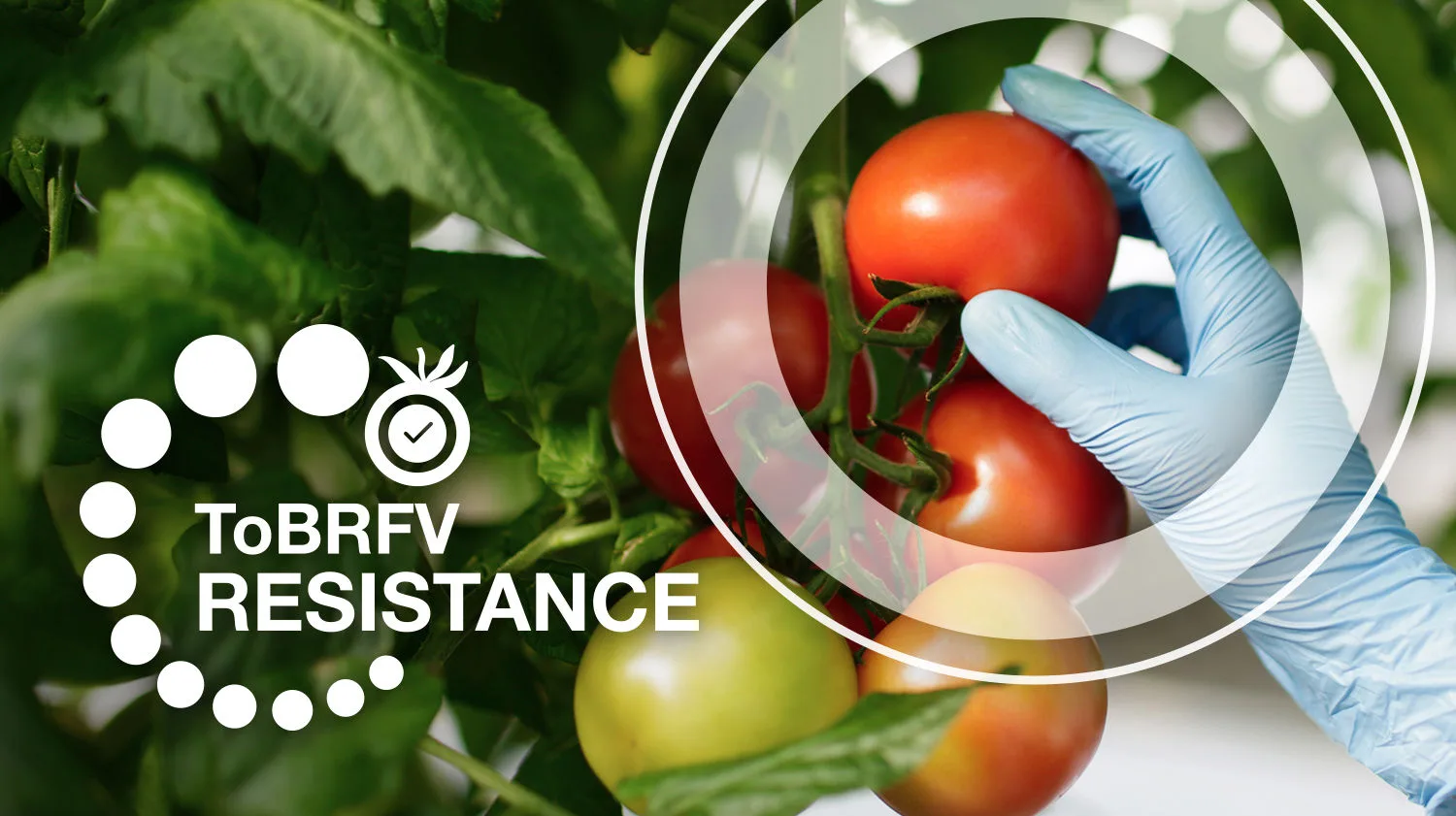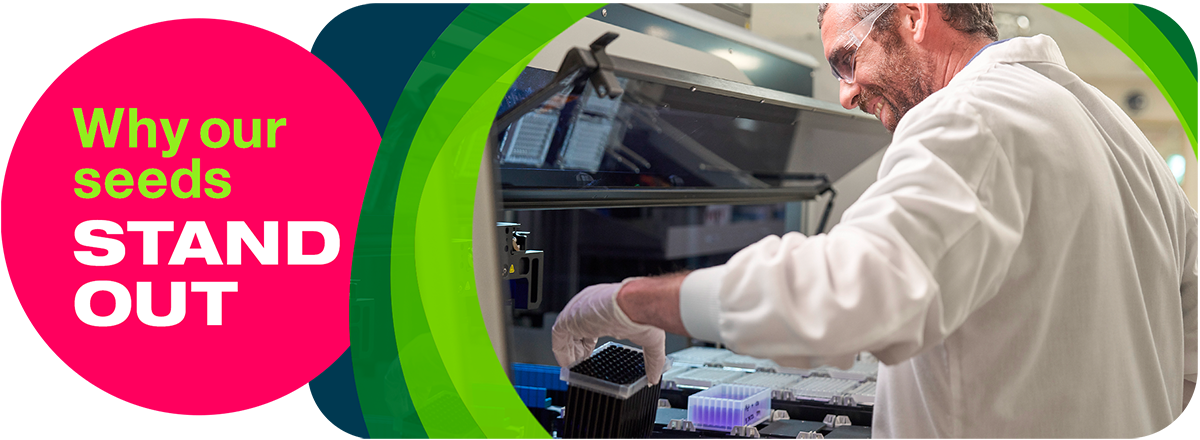Click here to download a PDF version of this spotlight.
» Vegetable seeds are tested by seed companies and regulatory agencies to evaluate seed quality and seed health.
» Tests for germination and seed vigor help achieve desired levels and stand establishment and early plant growth.
» Pathogen testing helps to reduce the distribution of seedborne pathogens and the initiation of plant disease epidemics.
Commercial vegetable seeds are routinely tested before they are distributed to growers. Tests are used to evaluate seed quality and to check for the presence of pests and pathogens that could pose a risk to production and the environment. Seed testing is carried out by seed companies, regulatory agencies, and private laboratories. Seed testing labs are typically accredited by the International Seed Testing Association (ISTA). Seed companies and regulatory agencies participate as members of industry associations, such as ISTA and the International Seed Health Initiative for Vegetable Crops, and academic societies, such as the American Phytopathological Society, to help promote seed quality and safety practices throughout the industry.1,2
The ISTA has established rules and procedures used to test and certify seeds.1 Accredited labs can certify seed lots to help satisfy import/export requirements. Sampling and testing of seed lots must be carried out in accordance with ISTA procedures by accredited labs.1
SEED COMPANY AND REGULATORY TESTING
Seed companies routinely test seeds to evaluate quality characteristics, including germination rate, moisture content, seed size and weight, and evaluations of vigor. Companies also test for the presence of important common and emerging pathogens, including viruses, bacteria, fungi, and some nematodes. A range of technologies are used to evaluate these characteristics, from visual observations to molecular assays and genome sequencing.2
Regulatory agencies require the testing of seeds destined to be imported into different countries or sometimes between states or provinces within a country. In the U.S., the Federal Seed Act (FSA) regulates the interstate shipment of vegetable seeds under a partnership between the USDA Agricultural Marketing Service (AMS) and state departments of agriculture.3 Routine FSA testing requirements include tests for purity, germination, moisture content, conductivity, seed count, the presence of pathogens and noxious weed seeds. Testing for varietal labeling verification is also available on request.1,3,4
CYCLE AND CONDITIONS
Phytophthora capsici overwinters in infested crop debris, as spores in the soil, and on the roots of some weed species. Phytophthora spores can remain viable in the soil for over ten years. The pathogen has a wide host range, including other crop and weed species. The pathogen is spread by the movement of spore-like structures called sporangia, mostly in splashing and flowing water. Sporangia can germinate and produce hyphae that directly infect the plant, or they can release 20 to 40 swimming zoospores that can move in films of water on plant surfaces before infecting the plant, increasing the number of infections resulting from one sporangium.1,2
Disease spread and development are favored by warm (77°F, 25°C) and wet conditions. Overhead irrigation, rainfall, high relative humidity, and sites with poorly drained soils all contribute to increased disease severity. The disease is often most severe in low-lying areas of the field, where the soils remain saturated for extended periods. Dispersal patterns often follow paths of water drainage in the field, usually preading along rows faster than across rows.1,2 Some studies have reported a higher incidence of fruit rot later in the season, giving rise to speculation that older fruit may be more susceptible to infection by Phytophthora. However, a study specifically looking at the effects of fruit age on susceptibility found that fruit are equally susceptible at all ages, and fruit rot levels were not correlated to fruit sugar content.6
GERMINATION
Germination tests determine the percentage of seeds that produce seedlings with healthy roots and shoots under favorable conditions.5 One method of germination testing is the top paper method, where seeds are placed on the top of wet filter paper in a Petri dish. Another method is to place seeds in a line on moist paper towel, and then the towel is rolled up and placed vertically in a tray. With either method, the seeds are incubated at the optimal temperature for the crop, usually between 64° and 77°F (18° and 25°C) for seven to twenty-eight days, depending on the crop. Germinated seeds are counted at regular intervals (Figure 1). Germination results will typically include the percentage of normal and abnormal seedlings and the percentage of hard, dead, or decayed seeds. Hard seeds are living seeds that cannot absorb water because of their seed coat. Comments on specific abnormalities and the presence of fungal growth from the seeds may be included.1,5
PURITY
Seed lot purity is a determination of the percentage of seed in the sample of the specific crop and variety. Samples are evaluated for the presence of seeds of other varieties, other crop species, and weed species, including noxious weeds. The presence and amounts of defective seeds and inert non-seed contaminants are also recorded. Results are usually expressed as a percent by weight of the sample.1,5
Vegetable seed testing
MOISTURE CONTENT
The moisture level in seeds is an important measure of seed quality that has implications for the storability of the seed lot. Moisture content can be determined using a gravimetric method in which a seed sample is weighed, placed in a drying oven for a specified amount of time, and then reweighed. The difference in the pre- and post-dried weights is used to determine the percent moisture level. Calibrated seed moisture meters are also used to quickly determine the moisture content of a seed lot.1,5
Seeds are tested for the presence of pathogens to help prevent the development and spread of seedborne diseases. Pathogen testing is often a requirement for the certification of imported seeds.1 Each crop can have a number of high-risk pathogens or problematic seedborne diseases that seed companies and regulatory agencies are concerned about.1,2 Specific tests are used to detect the presence of these pathogens. For example, seeds of Brassica crops are routinely tested for the presence of the bacterial pathogen that causes black rot. A PCR (polymerase chain reaction) assay is used to detect the presence of pathogen DNA. Lettuce seeds are evaluated for the presence of lettuce mosaic virus with an antigen/antibody-based ELISA (enzyme-linked immunosorbent assay) test.1 Sometimes, potential pathogens are detected during visual inspection of the seed, and further testing may be needed to determine if the observed organisms are pathogenic.
The results of pathogen tests can be reported as qualitative (present/absence) or as quantitative (inoculum level) values. When specific pathogens are detected, they should be listed on the test report using their scientific names, and some indication of the percentage of infected seeds may be noted.1
DISEASES/ PATHOGENS
Seeds are tested for the presence of pathogens to help prevent the development and spread of seedborne diseases. Pathogen testing is often a requirement for the certification of imported seeds.1 Each crop can have a number of high-risk pathogens or problematic seedborne diseases that seed companies and regulatory agencies are concerned about.1,2 Specific tests are used to detect the presence of these pathogens. For example, seeds of Brassica crops are routinely tested for the presence of the bacterial pathogen that causes black rot. A PCR (polymerase chain reaction) assay is used to detect the presence of pathogen DNA. Lettuce seeds are evaluated for the presence of lettuce mosaic virus with an antigen/antibody-based ELISA (enzyme-linked immunosorbent assay) test.1 Sometimes, potential pathogens are detected during visual inspection of the seed, and further testing may be needed to determine if the observed organisms are pathogenic.
The results of pathogen tests can be reported as qualitative (present/absence) or as quantitative (inoculum level) values. When specific pathogens are detected, they should be listed on the test report using their scientific names, and some indication of the percentage of infected seeds may be noted.1
INTERPRETING RESULTS
Germination tests indicate the percent germination under optimal conditions. If a grower plants the seeds in the field or greenhouse where conditions are not optimal, then precent germination numbers may be lower than what the test reports. Results from a vigor test may provide a better indication of real-world germination and stand establishment rates.
Moisture levels can provide an indication of the storability of the seed. Seeds with lower moisture levels tend to tolerate longer storage times than seeds with higher levels of moisture. High-moisture seeds are more susceptible to seed rot pathogens. However, low-moisture seeds may germinate more slowly.
Seed purity tests provide information on the potential contamination of seed lots with unwanted seeds that can throw off planting density calculations and introduce undesirable plant species into the planting. Debris and over or undersized seeds can also result in clogging and other problems with planting machinery.
Tests for specific pathogens can alert seed companies and growers that the seed may be infected with potentially harmful pathogens, resulting in possible disease epidemics if planted. Threshold levels have been established for the acceptable number of infected seeds in a seed lot, and when those thresholds are exceeded, that seed lot should not be used. Visual observations of seed may also result in the report of the presence of potential pathogens. Such reports do not verify that the organisms observed are pathogenic. Additional testing may be needed to determine if the seeds are safe to plant.
SOURCES
1 International Seed Testing Association (ISTA)
https://www.seedtest.org/en/home-1.html.
2 Seed health technology. Vegetables By Bayer.
https://www.vegetables.bayer.com/us/en-us/innovation/seed-technology.html.
3 Payne, R. 2017. USDA’s Seed Regulatory and Testing Division offers services to assist the industry. USDA. https://www.usda.gov/media/blog/2011/07/26/usdas-seed-regulatory-and-testing-division-offers-services-assist-industry.
4 Seed Testing & Clearance. USDA AMS. https://www.ams.usda.gov/services/seed-testing.
5 Seed Testing: how to test vegetable seeds. https://www.agricultureinindia.net/seed/seed-testing/seed-testing-how-to-test-vegetable-seeds-agriculture/19820.
6 Elias, S. and Garay, A. Tetrazolium test (TZ): a fast, reliable test to determine seed viability. Oregon State University Seed Laboratory.
Websites verified 1/27/2023
ADDITIONAL INFORMATION
Performance may vary from location to location and from year to year, as local growing, soil and weather conditions may vary. Growers should evaluate data from multiple locations and years whenever possible and should consider the impacts of these conditions on the grower’s fields. The recommendations in this article are based upon information obtained from the cited sources and should be used as a quick reference for information about vegetable production. The content of this article should not be substituted for the professional opinion of a producer, grower, agronomist, pathologist and similar professional dealing with vegetable crops.
BAYER GROUP DOES NOT WARRANT THE ACCURACY OF ANY INFORMATION OR TECHNICAL ADVICE PROVIDED HEREIN AND DISCLAIMS ALL LIABILITY FOR ANY CLAIM INVOLVING SUCH INFORMATION OR ADVICE.
5011_167350 Published 01/23/2023





